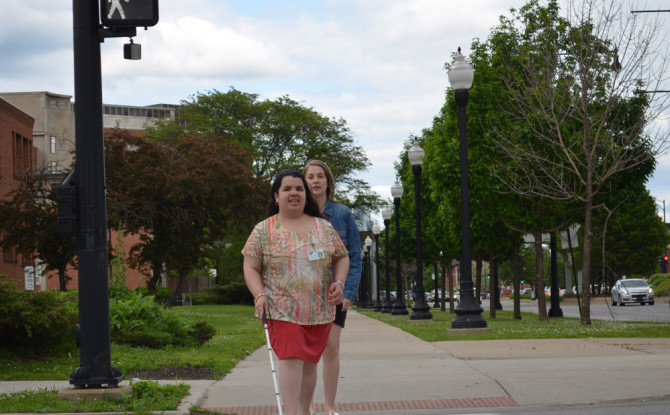
How Do People Who Are Blind Know When It Is Safe to Cross the Street?
May 28, 2015
Rather than “stop, look and listen” before crossing a street, those of us who can’t see eliminate the “look” part from the process. People who are blind or visually impaired learn to travel independently by using what is known as Orientation and Mobility, or O&M for short. We use our remaining senses (with the exception of taste) as well as our memory to get oriented to our surroundings and determine where we are going. This is the orientation part. The mobility aspect is the actual travel to our desired locations. Some of us will use white canes, while others prefer to use dog guides. People who still have some remaining vision might not need any of these mobility aids.
First and foremost, the remaining four senses of a blind person are not stronger because of the lack of sight. We’ve simply learned to pay close attention given that we have to use our other senses for the things for which sighted individuals use their vision.
So, as you might imagine after this crash course on O&M, those of us who can’t see know how to cross the street by listening to the sound of traffic. If we are at a crossing with a light, we can hear when the traffic moving on the street in front of us begins to slow down and eventually comes to a stop. Next, we will hear the traffic on the parallel street, in other words the intersecting street that is either on our left or right, beginning to move. This indicates to us that we have the green light and that it’s ok to cross.
If the blind person is at a street with no light, then he or she can simply listen for any oncoming vehicles. If no cars are heard, then they can go ahead and cross.
Some intersections have Accessible Pedestrian Signals (APS) to assist people with visual impairments in determining when it is safe to cross the street. These signals emit a sound – usually a beep or chirp (and occasionally speech) – so that the blind person knows which street has the green light. For example, if I’m standing at an intersection and hear a constant beep, I know that the street I’m about to cross has the green light. On the other hand, if I hear a chirping noise, then that means that the street alongside me has the green light.
Having explained this, however, it is also important to emphasize that blind people should not rely solely on Accessible Pedestrian Signals. They should always use caution and pay attention to the flow of traffic before deciding to cross. These audible signals should only be used as a supplemental type of assistance. After all, they are not available at all street crossings, and like any modern technology they are likely to malfunction at any given point.
A few other tips and things to keep in mind:
- Dog guides do not know when it is safe to cross the street! In fact, dogs are color blind and therefore cannot tell when the light changes from red to green. It is the owner’s responsibility to determine and let the dog know when it is safe to cross. If the dog doesn’t see cars coming, then it will begin guiding its owner across.
- Never honk your horn or give verbal directions to a blind person who is about to cross the street! While I appreciate people’s thoughtfulness and kindness, these types of actions are not helpful at all. Rather, they are a distraction and may even pose a danger to individuals like me who are blind or visually impaired.
- Never grab or pull a person who is trying to cross the street. If you think we might need help, always ask; never assume. If we accept your assistance, we will let you know the best way you can help.
- Cars with hybrid engines are often very quiet for blind pedestrians to notice. For this reason the Pedestrian Safety Enhancement Act was signed into law by President Obama in 2011. Under this law, car manufacturers have to provide audible alerts on hybrid vehicles so that blind individuals are aware of their presence.
Check out this article for more information about this legislation and about other tips for assisting blind pedestrians.
We would appreciate your comments about this or other topics. Also, if you have any questions related to visual impairment or blindness, please email them to sandysview@chicagolighthouse.org. Thanks for reading, and have a great day!





